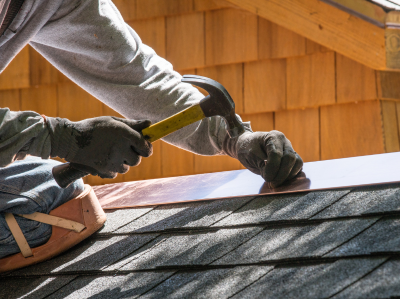Roof Flashing: What Is It & How Do You Install It?

In most cases, water damage to the inside of the home is caused by a leak in the roof. This may look like a small problem at first, but it may lead to greater damage to your home or office. One of the best ways to solve it is by installing roof flashing and thus preventing potential damage.
Roof flashing comes in a variety of styles that is employed in various situations. Some are intended to be installed by roofers around features such as chimneys, roof windows, and vents. Others are intended to protect the roof where it meets the house wall.
If you’re wondering, “What is roof flashing?” and if it is important for you, keep reading this article. We’ll also cover how to install flashing on a roof, the benefits of having it, and the potential consequences of not having it.
What Is Roof Flashing?
Wondering, “What is roof flashing?”
Roof flashing is a flat material used by roofers and constructors to waterproof roof portions prone to leaks. It is typically made from metal, such as aluminum or copper, and usually installed in areas where the roof meets a vertical surface, such as a wall or chimney, so that water can flow down the roof and into the drain.
However, this can change depending on the type of roof and the flashing. Simply put, the purpose of flashing is to create a barrier that directs water away from vulnerable areas on the roof, preventing water damage.
Types of Roof Flashing
There are several types of roof flashing. Determining which one to use can be tricky, which is why you should first understand the most common types. The most common ones include:
- Step flashing – It is used on shingle roofs and involves installing small pieces of flashing behind each course of shingles.
- Continuous flashing – This one is used on flat roofs and creates a continuous barrier along the entire length of the roof-to-wall intersection.
Another distinction we can make is according to the placement of the flashings and their shapes. Some common shapes include L-shaped step flashing, J-shaped counter flashing, and Z-shaped continuous flashing.
How to Use Flashing & Why Should You Get It?
Installing roof flashing the right way and maintaining it is essential to guarantee the longevity and efficacy of your roof. If not properly installed or maintained, roof flashings can become damaged, allowing water to penetrate the roof and cause damage to the interior of the home.
How to Use It
To properly use roof flashing, it is vital to understand the different types and the appropriate installation methods for each. So, how to use flashing?
For example, as we mentioned, step flashing is used on shingle roofs, and it has to be installed behind each course of shingles. On the other hand, the continuous flashing has to be placed like a barrier along the roof-to-wall intersection.
Proper installation is vital for the efficacy of flashing. Although theoretically, it may seem simple, installing roof flashings is not something everyone can do. That is why it’s best to hire professionals to take care of the problem.
Why Should You Have It?
Having flashing in your roofing system is a savvy investment for your home. It can prevent costly repairs and even structural damage caused by water penetrating the roof. To ensure the proper functioning of the flashing, it is important to have it inspected periodically and to make any necessary repairs or replacements promptly.
How to Install Flashing on a Roof? A Description of the Process
Installing flashing on a roof is a crucial step in safeguarding your property from any type of water damage. The process involves several steps, including measuring and cutting the flashing, preparing the surface, applying flashing cement, installing the flashing, and checking and inspecting the installation.
Below is a more meticulous explication of each step.
Step 1: Measure and Cut Flashing
The first step is to measure the area where the flashing will be installed. This will help to select the accurate size and shape of the flashing that is needed. Once the measurements are taken, the flashing can be cut to the correct size and shape.
Step 2: Prepare the Surface
Before installing the roof flashing, it is important to prep the surface where the flashing will be installed. This may involve cleaning the area, removing any old flashing, or making any necessary repairs to the roof. Suitable surface preparation is vital to guarantee that the flashing will adhere correctly.
Step 3: Apply Flashing Cement
Once the surface is prepared, the next step is to apply flashing cement to the area where the roof flashing will be installed. This will help to create a secure bond between the flashing and the roof.
Step 4: Install the Flashing
The next step is to install the flashing in the correct location. This may involve attaching the flashing to the roof using nails or other fasteners. It is vital to ensure that the flashing is placed at a level and that it is properly sealed to stop water from penetrating through.
Step 5: Check and Inspect
Finally, it is important to check and inspect the installation to ensure that it has been completed correctly. This may implicate checking for proper alignment and examining for any leaks or additional problems. Any crucial repairs or alterations should be made at this time.
Note: Besides knowing what is flashing on a roof and how it’s done, it is crucial to remember that flashing installation can’t always be done by oneself. It is always advised that installing roof flashing is done by a professional since it requires proper measurement, cutting, and placement. Call our skillful team at Aabrite today, and let us help you fix your roof!
How to Install Roof Flashing Against a Wall?
Installing roof flashing against a wall is as crucial as placing it on your roof. This will also help safeguard your home from water damage. The process of installing flashing against a wall may vary, but the general steps are similar to the ones used when installing it on a roof. They go as follows:
Step 1: Measure and Cut
The first step is exactly the same as for installing the flashing on a roof. As we said, this will help to determine the correct size and shape of the flashing that is needed. Once you take the measurements, you can cut it to the right size and shape.
Step 2: Clean the Surface
Before installing the flashing, make sure that you prepare the surface. Clean the area, remove any old flashing, or make necessary repairs to the wall. This will leave you with a “clean wall” on which you can start working.
Step 3: Stick the Flashing to the Wall
Once you prepare the surface, the next step is to apply flashing cement to the area where the flashing will be installed against the wall. This way, you’re sure that the flashing sticks in all situations.
Step 4: Place the Flashing
Next comes the main part – putting the flashing in the correct location against the wall. Make sure that you stick it securely to the flashing cement and on the right area.
Step 5: Let it Dry & Inspect
Finally, let the flashing dry-stick to the wall, meaning let the cement harden and lock in the flashing to the wall. This should mainly take 1 day. After that, you can check how you’ve finished the work and whether or not you need to fix some places. This step is crucial in making sure that any following potential water damage is prevented.
Roof Flashing: Should You Get It?
The short answer is yes. Roof flashing can only bring benefits to your home – now and in the long run. Although you may think that your roof can do without roof flashings, it is far better for any type of roof to have this component. The reason is quite simple – it aids in preventing water from penetrating through the roof and into the home.
However, to get the most out of this advantage, you need to have your roof flashings installed properly. Correct installation and maintenance are essential to ensure the longevity and effectiveness of a roofing system.
Needless to say, it can prevent costly repairs caused by water damage. Remember that installing it is not enough – regular inspection and maintenance are highly important to prolong the flashings’ lifespan.
FAQ
What does flashing on the roof look like?
Roof flashing usually blends with the roof (if colored) and thus can be tricky to spot.
In some cases, this component of the roof is placed under the shingles or tiles so that the house can keep its overall design. But in others, you can spot it as usually metal or aluminum pieces placed around the chimney, vents, or skylights.
Do I need roof flashing?
It is advised that all houses have roof flashing since it’s essential in deterring water from entering the house.
What are the different types of roof flashing?
There are several types of roof flashing. The most common ones are step flashing and continuous flashing. But there is also counter flashing and cricket flashing.

